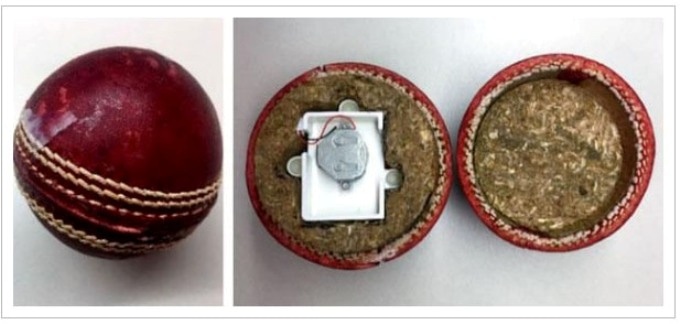Coaches, players and fans may soon be entering into the dawning of a new age of sports analytics with sensor-based equipment that can send data directly to a smartphone.
 The sensors are wrapped in a protective case and embedded in a cricket ball. They employ inferencing algorithms that can track movement to within a few centimeters, and accurately characterize 3-D ball motion, such as trajectory, orientation, and revolutions per second. Credit: University of Illinois
The sensors are wrapped in a protective case and embedded in a cricket ball. They employ inferencing algorithms that can track movement to within a few centimeters, and accurately characterize 3-D ball motion, such as trajectory, orientation, and revolutions per second. Credit: University of Illinois
Researchers at the University of Illinois at Urbana-Champaign have utilized inexpensive Internet of Things (IoT) devices, which are low-cost sensors and radios that can be embedded into sports equipment like balls, rackets and shoes, as well as utilized as wearable devices.
With sensors placed in sports equipment, coaches will be able to track how fast the ball is moving or how players move across the field—a key component of how they make adjustments in-game and how fans view the games, without having to outfit stadiums and arenas with expensive cameras.
“There's a lot of interest in analyzing sports data though high-speed cameras but a system can cost up to $1 million to implement and maintain,” Mahanth Gowda, a Ph.D. candidate in computer science and lead author of the study, said in a statement. “It's only accessible to big clubs.
“We want to cut down the expense significantly by replacing cameras with Internet of Things devices to make it possible for many other organizations to use the technology,” he added.
The devices cost less than $100 each.
The team was able to develop advanced motion tracking algorithms from the various incomplete and noisy measurements of inertial measurement unit (IMU) sensors and wireless radios, fitted inside a ball and players’ shoes.
The tiny sensors, which are wrapped in a protective case and distributed evenly in equipment, use inferencing algorithms to track movement within a few centimeters, while also accurately characterizing 3D ball motion, such as trajectory, orientation and revolutions per second.
“This level of accuracy and accessibility could help players in local clubs read their own performance from their smartphones via Bluetooth or school coaches could offer quantifiable feedback to their students,” Roy Choudhury, an associate professor of electrical and computer engineering and computer science at Illinois, said in a statement.
The feedback could also help with detecting and analyzing player injuries like concussions.
For example, the sensor inside a soccer ball can measure how hard it hits a player’s head, giving coaches an indication about whether to treat the player for a possible concussion.
“We've truly scratched the surface for applications with these sensors,” Gowda said. “The algorithms provide extremely fine-grained detail and accuracy in measurements, but use common measuring tools that can be found in any smartphone.”
The plan originally studied the 3D trajectory and spin parameters of a cricket ball. However, the researchers believe the core motion tracking techniques can be adopted in many different sports analytics, a burgeoning market.
“We're motivated to develop this technology to help coaches make better decisions on and off the field and provide enhanced entertainment to viewers,” Choudhury said. “We want to bring advanced but affordable sports analytics to everyone, anywhere, anytime.”